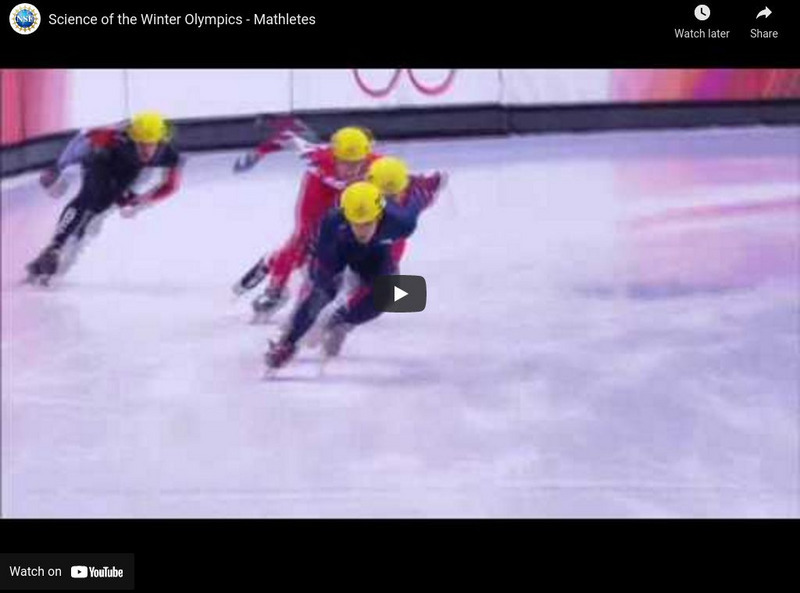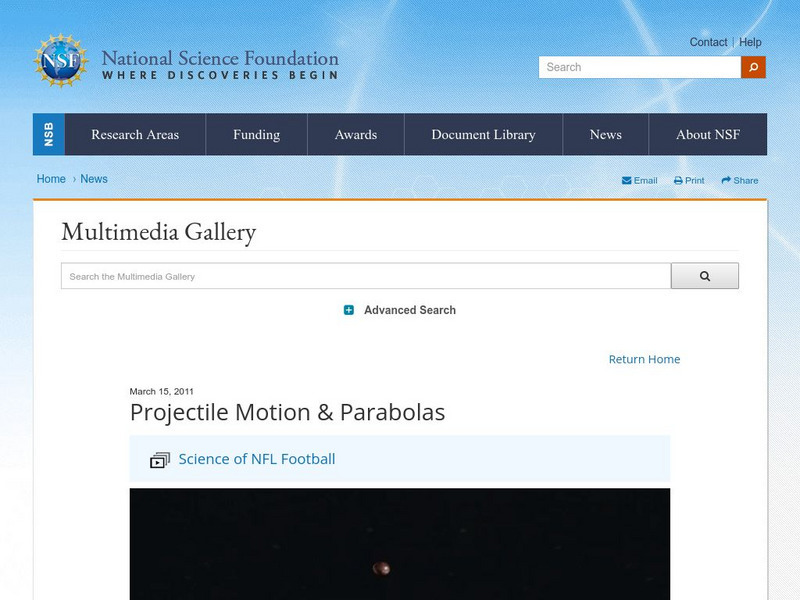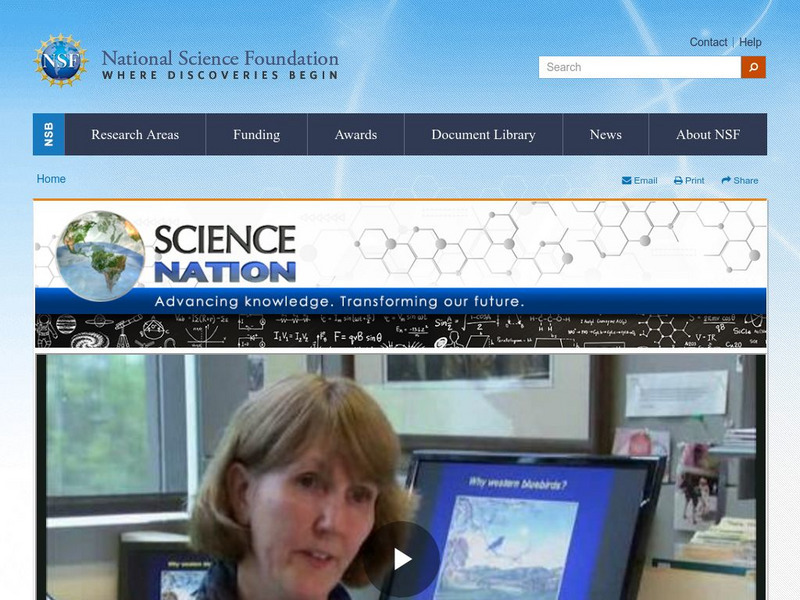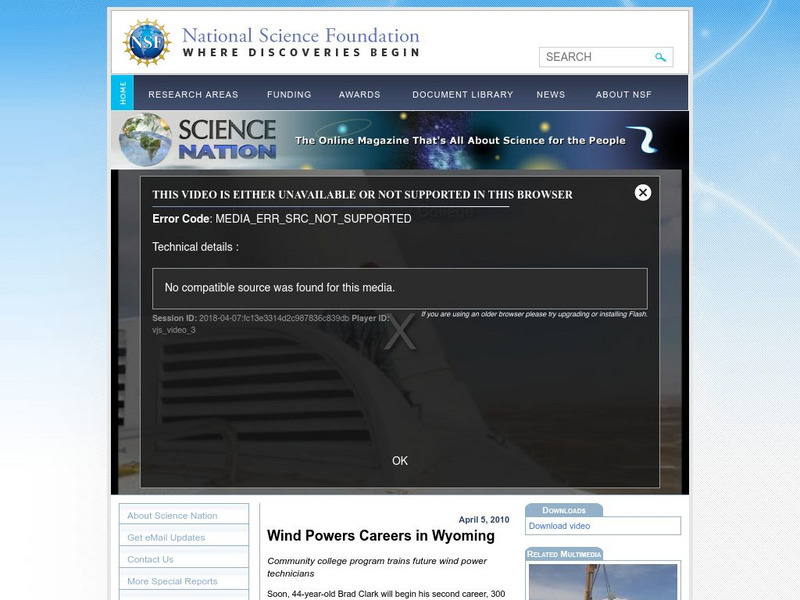Hi, what do you want to do?
National Science Foundation
National Science Foundation: Chemistry of Water
Video that explores the properties of the water molecule as a "universal" solvent. Content is explained in plain, easy-to-understand language with simple analogies for young chemistry students. [4:46]
National Science Foundation
National Science Foundation: Science of the Winter Olympics: Aerial Physics
In the sport of freestyle aerials, skiers are judged on their ability to perform complex jumps in the air. Emily Cook, a 12-year veteran of the U.S. Freestyle team, and Paul Doherty, a Senior Scientist at the Exploratorium in San...
National Science Foundation
National Science Foundation: Science of the Winter Olympics: Slapshot Physics
One of the most popular team sports in the Winter Olympics is hockey. More than just a physical game, for scientists, it's a showcase for physics on ice - especially when it comes to the slapshot. Three-time Olympian Julie Chu, Thomas...
National Science Foundation
National Science Foundation: Science of the Winter Olympics: Figure Skating
Every four years, we watch the stakes for Olympic figure skaters get higher, as they try to increase rotation in the air with their triple axels and quadruple toe loops. How do they do that? It's a scientific principle that Olympic...
National Science Foundation
National Science Foundation: Science of the Winter Olympics: Science of Skates
The ice skates worn by hockey players, figure skaters and speed skaters are vastly different from what were once used. Melissa Hines, the Director of the Cornell University Center for Materials Research, and Sam Colbeck, a retired...
National Science Foundation
National Science Foundation: Science of the Winter Olympics: Blade Runners
Speed skating is all about force and movement - what, in physics, are known as Newton's First Three Laws of Motion. J.R. Celski, a U.S. speed skater, and physicist George Tuthill of Plymouth State University explain.
National Science Foundation
National Science Foundation: Science of the Winter Olympics: Banking on Speed
The winter games in Vancouver provided a chance for the United States' four-man bobsled team to win its first gold medal in more than 60 years. With the help of Paul Doherty, senior scientist at the Exploratorium in San Francisco,...
National Science Foundation
National Science Foundation: Science of the Winter Olympics: The Science of Skis
In skiing events like the downhill, slalom or ski jump, it's often the skis that are bound to an athlete's feet - and the materials used to make them - that give these athletes an edge over the competition. U.S. Ski Team members Julia...
National Science Foundation
National Science Foundation: Science of Winter Olympics: Science of Snowboarding
To get "max air" off the half-pipe without losing their balance, snowboarders might want to check out this experiment that Paul Doherty, a senior scientist at the Exploratorium in San Francisco, cooked up, using a skateboard and a glass...
National Science Foundation
National Science Foundation: Science of the Winter Olympics: Mathletes
It's been called "the Queen of Sciences" - mathematics. It might not be as obvious in Olympic sports as physics or materials-engineering, but math - from simple arithmetic to calculus - is part of every jump, every spin, every move the...
National Science Foundation
National Science Foundation: Science of the Winter Olympics: Internal Athletes
Cross-country skiers are among the fittest athletes in the world. Deborah King, an associate professor in the Department of Exercise and Sports Sciences at Ithaca College and Joseph Francisco, president of the American Chemical Society,...
National Science Foundation
National Science Foundation: Science of the Winter Olympics: Science Friction
Curling has been in the Winter Olympics for a while now, but it still seems a little strange to most of us. John Shuster, the captain - or "skip" - of the U.S. Curling Team in the Vancouver Winter Olympics, explains this unusual sport,...
National Science Foundation
National Science Foundation: Science of the Winter Olympics: Competition Suits
Olympic athletes have long worn special competition clothing to gain an edge. Science and technology continue to improve on what they wear. Hear from Olympians Chad Hedrick, Steve Holcomb and Erin Hamlin, and Melissa Hines, the director...
National Science Foundation
National Science Foundation: Science of Nfl Football
A collection of ten videos that examine the physics and math behind NFL football. They cover topics such as Newton's Laws of Motion, the Pythagorean Theory, kinematics, and projectile motion.
National Science Foundation
National Science Foundation: Science of the Olympics: Engineering in Sports
A collection of 36 videos that examine the science behind different sports of the Olympics.
National Science Foundation
National Science Foundation: Science of the Winter Olympics
A collection of twenty six videos that examine the science behind different sports of the Winter Olympics.
National Science Foundation
National Science Foundation: Projectile Motion & Parabolas
Students learn about the science of NFL football. The video discusses projectile motion, parabolas, and the significance of velocity on the trajectory every time an NFL punter kicks a football into the sky. [4:16]
National Science Foundation
National Science Foundation: Geometric Shapes: Spheres, Ellipses and Spheroids
Students learn about the science of NFL football. The video [4:10] discusses how the three-dimensional shape of a football helps an NFL quarterback throw a hard, accurate pass.
National Science Foundation
National Science Foundation: Batty for Bats
A look at bats including physical structure, food, and habitats. More specifically, their structure for flight may provide an aerodynamic model for future air crafts. Video is included as are links to related topics. [2:34] (April 12, 2010)
National Science Foundation
National Science Foundation: Science Nation: Citizen Science
A video that explores how volunteers collect data and make observations to help scientist understand birds and their changing habitats. [2:33]
National Science Foundation
National Science Foundation: Wind Power Careers in Wyoming
A look at new careers offered in wind energy at community colleges in the state of Wyoming. The role of wind power technicians is discussed as is the program they take. A video clip is included. [2:34]
National Science Foundation
National Science Foundation: Home Sensors Enable Seniors to Live Independently
Researchers are developing smart home technologies to enhance the safety of residents and monitor their health conditions using sensors and other devices. [2:48]
National Science Foundation
National Science Foundation: One Day We May Fill the Tank With Fungi Fuel
Scientists have discovered a way to use microorganisms to generate hydrocarbons. It is hoped that this idea could eventually be used to create fuel. [2:45]
National Science Foundation
National Science Foundation: Killing Cancer: Novel Brain Tumor Treatment Inspires Hope
Describes a new type of treatment for deadly brain cancer that uses white blood cells to transport anticancer drugs to tumors. [4:45]























